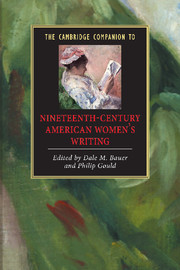Book contents
- Frontmatter
- Introduction
- Part I Historical and theoretical background
- Part 2 Genre, tradition, and innovation
- 4 Captivity and the literary imagination
- 5 Nineteenth-century American women's poetry
- 6 Women at war
- 7 Women, anti-Catholicism, and narrative in nineteenth-century America
- 8 Immigration and assimilation in nineteenth-century US women's writing
- Part 3 Case studies
- Conclusion
- Index
4 - Captivity and the literary imagination
from Part 2 - Genre, tradition, and innovation
Published online by Cambridge University Press: 28 May 2006
- Frontmatter
- Introduction
- Part I Historical and theoretical background
- Part 2 Genre, tradition, and innovation
- 4 Captivity and the literary imagination
- 5 Nineteenth-century American women's poetry
- 6 Women at war
- 7 Women, anti-Catholicism, and narrative in nineteenth-century America
- 8 Immigration and assimilation in nineteenth-century US women's writing
- Part 3 Case studies
- Conclusion
- Index
Summary
In Playing in the Dark: Whiteness and the Literary Imagination, Toni Morrison argues that the central themes of American literature - “autonomy, authority, newness and difference, absolute power” - are engendered, molded, and “activated by a complex awareness and employment of a constituted Africanism.” Morrison contends that race undergirds even much classic American literature because consciously and unconsciously nineteenth- and twentieth-century American authors dramatized and narrativized the essence of slavery through the trope of the “civilized” free (masters) and the “savage” unfree (slaves). Arguing against overly conservative or literal readings, she concludes, “It would be a pity if the criticism of that literature continued to shellac those texts, immobilizing their complexities and power and luminations just below its tight, reflecting surface. All of us, readers and writers, are bereft when criticism remains too polite or too fearful to notice a disrupting darkness before its eyes” (Morrison, Playing in the Dark, 90-1).
Complementing this postcolonial response is Sandra M. Gilbert and Susan Gubar’s classic feminist interpretation of the nineteenth-century American female Gothic as employing the archetypal symbol of the “madwoman in the attic.” These cooped-up women subjects in the literature – perhaps best exemplified by the unnamed narrator in Charlotte Perkins Gilman’s famous short story “The Yellow Wallpaper” – are physically confined by their surroundings, but they are also confined by other forms of oppression, including the psychological, sexual, and social. Indeed, in that regard, the pun on the meanings of “confinement” as enslavement and also childbirth is highly significant.
- Type
- Chapter
- Information
- Publisher: Cambridge University PressPrint publication year: 2001



